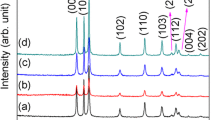Abstract
Zinc oxide nanostructures were prepared by chemical route using Zinc nitrate and hexamethylenetetramine as starting material. Two different processes: simple chemical route with and without electrodeposition were carried out for obtaining thin films on glass substrates. Different structures were obtained using the two techniques. SEM images show that zinc oxide prepared by simple chemical route using a seed layer is in the form of uniform structure consisting of nanorods of very short length. On the other hand nano rods of larger dimensions were obtained by the electrodeposition technique on transparent conducting glass plates.
Access this chapter
Tax calculation will be finalised at checkout
Purchases are for personal use only
Similar content being viewed by others
References
Gyu-Chul Y, Chunrui W. and Won II P. “ZnO nanorods: synthesis, characterization and applications” Semicond. Sci. Technol, 20, S22, 2005
Qiuxiang Z, Ke Y, Wei B, Qingyan W, Feng X, Ziqiang Z, Ning D, Yan S, “Synthesis, optical and field emission properties of three different ZnO nanostructures”, Materials Letters, 61, 3890, 2007
Yuzhen L, Lin G, Huibin X, Lu D, Chunlei Y, Jiannong W, Weikun G, and Shihe Y, Ziyu W, “Low temperature synthesis and optical properties of small-diameter ZnO nanorods”, J. Appl. Phys, 99, 114302, 2006
Hachigo A, Nakahata H, Higaki K, Fujii S and Shikata S-I, “Heteroepitaxial growth of ZnO films on diamond (111) plane by magnetron sputtering”, Appl. Phys. Lett, 65, 2556, 1994
Morkoc H, Strite S, Gao G B, Lin M E, and Sverdlov B, and M. Burns, “Large-band-gap SIC, Ill-V nitride, and II-VI ZnSe-based semiconductor device technologies”, J.Appl. Phys, 76, 1363, 1994
Spanhel L and Anderson M A, “Semiconductor Clusters in the Sol-Gel Process: Quantized Aggregation, Gelation, and Crystal Growth in Concentrated ZnO Colloids”, J.Am. Chem. Soc, 113, 2826, 1991
Bagnall D M, Chen Y F, Shen M Y, Zhu Z, Goto T and Yao T, “Room temperature excitonic stimulated emission from zinc oxide epilayers grown by plasma-assisted MBE”, J.Cryst. Growth, 184/185, 605, 1998
L Hadjeris, L Herissi, M B Assouar, T Easwarakhanthan, J Bougdira, N Attaf and M S Aida, “Transparent and conducting ZnO films grown by spray pyrolysis”, Semiconductor Science and Technology, 24, 035006, 2009
C Lin, Y Li, “Synthesis of ZnO nanowires by thermal decomposition of Zinc acetate dehydrate”, Materials Chemistry and Physics, 113, 334–337, 2009
D. C. Look, D. C. Reynolds, C. W. Litton, R. L. Jones, D. B. Eason, and G. Cantwell, “Characterization of Homoepitaxial p-type ZnO grown by molecular beam Epitaxy”, Applied physics letters, 81, 1830, 2002
Acknowledgments
The authors are thankful to Dr. Ashok K Chauhan for continuous encouragements. One of the authors (N Gupta) is thankful to DST for funding the research fellowship. We are thankful to Mr. Shiv Kumar for help provided in taking the SEM images.
Author information
Authors and Affiliations
Corresponding author
Editor information
Editors and Affiliations
Rights and permissions
Copyright information
© 2014 Springer International Publishing Switzerland
About this paper
Cite this paper
Gupta, N., Nanda, O., Kumar, P., Jain, V.K., Saxena, K. (2014). Synthesis of Zinc Oxide Nanostructures by Chemical Routes. In: Jain, V., Verma, A. (eds) Physics of Semiconductor Devices. Environmental Science and Engineering(). Springer, Cham. https://doi.org/10.1007/978-3-319-03002-9_163
Download citation
DOI: https://doi.org/10.1007/978-3-319-03002-9_163
Publisher Name: Springer, Cham
Print ISBN: 978-3-319-03001-2
Online ISBN: 978-3-319-03002-9
eBook Packages: Earth and Environmental ScienceEarth and Environmental Science (R0)




